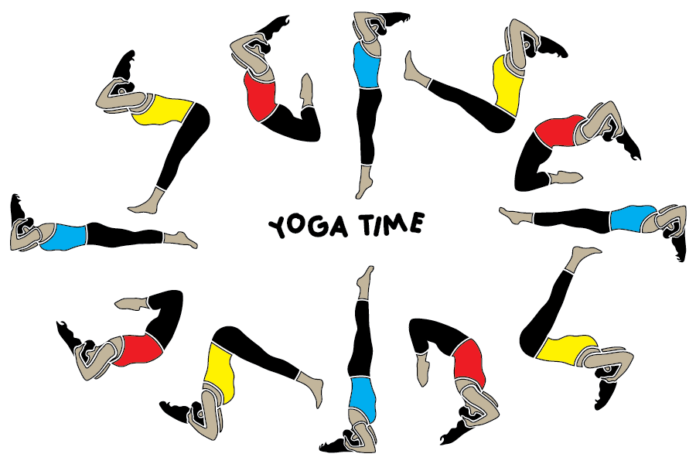The ancient practice teaches mindfulness in place of the Western fitness mentality
By CORALIE LOON — arts@theaggie.org
Since the westernization of yoga in the late 19th century, yoga has become a popular form of exercise that inevitably relates to themes of cultural erasure and whitewashing. However, it also offers an important alternative to mainstream workout culture through its emphasis on mindfulness and on fostering a deeper mind-body connection.
According to a Forbes article, 7% of people list exercising as a New Year’s resolution and 20% of people list “losing weight.” Based on popular advice and sentiments shared on the internet, fitness culture often values goal setting, monetary investment and the monitoring of calories, traits which to some could be off-putting.
In many ways, yoga challenges these Western notions of mental and physical health that rely on a future-oriented mindset and self-scrutiny.
Yoga originated in India around 5,000 years ago. Its name is derived from the Sanskrit word “yuj,” which is mentioned in the Vedas, the oldest religious texts of Hinduism. Yoga comprises one of the six schools of Hindu philosophy and is often considered a “sister tradition” with Buddhism, a religion and philosophy based on meditation and the alleviation of suffering from material desires. Since its development, yoga has taken many different forms, offering various approaches to the same basic principles.
Akshat Patel, a third-year cognitive science major, helps lead “Yoga of the Heart” (@yoh.davis on Instagram), a student organization that started during the beginning of the COVID-19 pandemic. They practice Bhakti yoga, “which is yoga that is centered around love,” Patel said. “In our culture we practice something that is called devotional service, which means serving other people.”
“We invite students and we guide them through meditations. We also serve them food and we serve the community in many ways,” Patel continued.
For Patel, Bhakti yoga is an important part of his spiritual community and routine: “There’s a term called ‘sadhana’ which is your daily spiritual practice, and it’s something that is a spiritual muscle and you have to exercise it and work it out daily,” Patel said.
Part of the American adaptation of yoga, however, has been characterized by a de-emphasis of its spiritual and meditative aspects in favor of the physical aspect (or “asana,” the third limb of yoga). But the other limbs of yoga, including “pranayama” (breathing) and “dharana” (focused concentration), are just as important to understanding yoga’s full-spectrum ability to heal the body and mind.
Still, Western versions of yoga maintain ties to their roots and offer many people a way to combine an interest in spirituality with fitness goals. Ashley MacLean, a fourth-year clinical nutrition major, teaches Buti yoga, which was created in 2010 and combines vinyasa flow with cardio and dance, at the Activities and Recreation Center. According to MacLean, the term “buti” is a Hindu word that means “a cure that has been hidden or kept secret.”
While the practice allows participants to get their sweat on, it also focuses on connecting to and listening to your body. “If you’re running you’re just running, there’s no mind-body connection. If you’re biking, same sort of thing. Yoga gives you that connection one step farther with your body,” MacLean said.
Of course, yoga has plenty of physical benefits: increased flexibility, strength, improved sleep and better posture, just to name a few. But it also offers much more.
Aleshia Rose, a third-year communication major, started doing yoga as a first-year to quell her anxiety. “It helps me stay fit in a healthy way,” she said. “It helps me focus on my breathing, and I have a lot of issues with breathing… I think it makes me a better person.”
Because yoga and meditation encourage one to be observant and in-touch with the present moment, these practices naturally counter the forward-focused mentalities prevalent in mainstream workout culture. Instead of focusing on what goals or milestones will be reached, yoga offers an experience that is equally rewarding in the here and now, and cannot be measured by calories or pounds.
MacLean’s advice for those interested in yoga was to simply give it a try and not force it to click right away: “Yoga comes to you. It’s there for you when you need it.”
Written by: Coralie Loon — arts@theaggie.org





